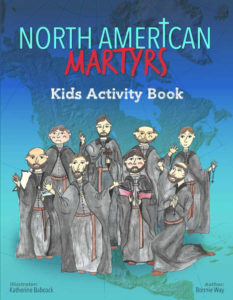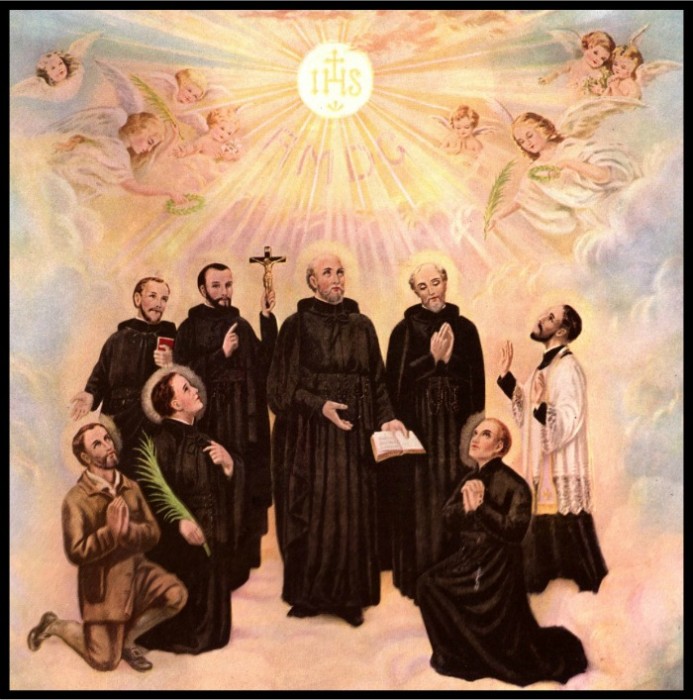Saint Noel Chabanel was born on February 2, 1613 in southern France. His name is less well-known among the Canadian martyrs. Like many of us moms, he worked in the background, doing everyday tasks. He sacrificed a life of ease to work with the Hurons of North America.
There were likely people who told him that he was wasting his education and abilities, just as moms today are told that when they choose to stay home with their children. Saint Noel’s faithfulness to God’s calling on his life can inspire many of us today to continue in the work that God has given us as well.

This post contains affiliate links; as an Amazon associate, I earn from qualifying purchases.
Noel became a Jesuit novice at the age of seventeen, following in the footsteps of an older brother. After his first vows in 1632, he taught rhetoric at several Jesuit colleges in Toulouse. He then studied theology for two years in preparation for his ordination in 1641. After that, he returned to teaching rhetoric, this time at Rodez. He gained a reputation as a brilliant teacher and could have made a noteworthy career in France.
Instead, he requested permission to go to New France as a missionary. Chabanel was likely familiar with the Jesuit Relations. These were the record of Jesuit missionary activity in New France (now eastern Canada). Historian Peter Ambrosie calls the Relations “one of the world’s most famous records of adventure, history and heroic sanctity, unique because they were history written on the spot in the hour of its making.” These fanned his desire to become a missionary himself.
Saint Noel Chabanel in Quebec
Father Chabanel arrived in New France on August 15, 1643. He received a warm welcome from the Jesuits there. Just the previous year, Rene Goupil had become the first Jesuit martyr after being captured, tortured, and murdered by the Iroquois.
Fr. Chabanel spent his first year in Quebec as a chaplain at the Ursuline convent. He also worked with the French soldiers and colonists in Quebec. During this time, he met Fr. Jean de Brebeuf, who served as supplier for the missions.
Saint Noel Chabanel among the Huron
 In the summer of 1944, two parties taking supplies to the Huron missions were ambushed by the Iroquois. The governor of New France finally provided an armed escort for Fr. Chabanel, Fr. Brebeuf and another priest to travel. They arrived at Ste. Marie in September and Fr. Chabanel began his studies of the Huron language.
In the summer of 1944, two parties taking supplies to the Huron missions were ambushed by the Iroquois. The governor of New France finally provided an armed escort for Fr. Chabanel, Fr. Brebeuf and another priest to travel. They arrived at Ste. Marie in September and Fr. Chabanel began his studies of the Huron language.
Unfortunately, he had great difficulty with this, as recorded by his superior, Father Paul Rageneau: “Once here, even after three, four, five years of study of the Indian language, he made such little progress that he could hardly be understood even in the most ordinary conversation.”
Because of his educated, upper-class background, Fr. Chabanel also struggled to adapt to the lifestyle of the Hurons. Historian Edward Spillane records that Fr. Chabanel “felt a strong repugnance to the life and habits of the Indians, and feared it might result in his own withdrawal from the work.”
Fr. Chabanel was sent in 1646 to another mission a short distance away from Ste. Marie. Because of his inability to speak the Huron language, he served in lesser roles but remained as busy as the other missionaries. Here, he also pronounced his final vows as a Jesuit. He returned to Ste. Marie in 1647 to help serve the Huron refugees.
In 1647, after Fr. Isaac Jogues became the second Jesuit martyr, Fr. Chabanel was given the opportunity to return to France. His great dislike of Huron food and culture, as well as his own spiritual dryness, likely made that an appealing offer. However, he refused, vowing instead that he would remain with the Huron until his own martyrdom—though he expected this would be “bloodless” as he daily gave himself up in service to the Huron.
Saint Noel Chabanel’s Death
The Iroquois threat to the Huron missions grew worse in 1648. Fr. Anthony Daniel became the fourth Jesuit martyr when his village, only eleven miles from Ste. Marie, was attacked by Iroquois. Fr. Brebeuf, serving six miles away at St. Ignace II, asked for help. Fr. Chabanel arrived that fall, “considering it a great privilege to be associated with this giant so courageous by nature and so endowed by grace” (Ambrosie).
During that winter, Fr. Chabanel helped build the mission. In February 1649, Fr. Chabanel was sent to St. Jean to help Fr. Charles Garnier. Even as he left, Fr. Chabanel had a premonition about his own martyrdom as well as Fr. Brebeuf’s. Barely a month later, he received the news of Fr. Brebeuf’s and Fr. Lalemant’s deaths.

While Fr. Chabanel worked at St. Jean, the other Jesuit missionaries dismantled Ste. Marie and moved their mission headquarters to Christian Island on Lake Huron. The constant attacks by the Iroquois had destroyed most of the Huron villages and decimated the Jesuit flocks.
In December, Fr. Chabanel was called to Christian Island because of famine at St. Jean and his superiors’ fears about the missionaries’ safety there. On his way, he was killed by a renegade Huron who threw his body into the Nottawasaga River.
Little did these noble martyrs who saw such scanty results accruing from their labors foresee that within a short time after their death, the truth they proclaimed would be embraced by their very executioners, and that their own successors would visit and Christianize almost every tribe with which the martyrs had been in contact. ~ Saints & Angels
St. Noel Chabanel Today
Soon after Noel Chabanel’s death, Father Rageneau began the process for the canonization of Noel and his fellow missionaries who had been slain by the Iroquois. Much of what we know about these missionaries, and their work during this time, comes from Father Rageneau’s writings. In 1652, he began collecting documents for the glorification of his fellow priests, whom public opinion already considered martyrs.
Along with the other seven Canadian Martyrs, Saint Noel Chabanel was canonized in 1930 by Pope Pius XI. Ambrose calls him “the silent hero of the hard trail, a patron of misfits, patron of the lonely, disappointed and abandoned.”
Today, schools and churches across North America are named for him. His name has also been given to a Church music project. The St. Noel Chabanel Responsorial Psalms are beautiful, solemn liturgical settings of the Responsorial Psalms for the entire liturgical year. Composer Jeffrey Ostrowski says, “I tried to set the sacred text to eminently dignified melodies, worthy of the Church’s public worship of God. If I were to name an unusual element, it would be the different harmonizations I provide for the Chabanel Refrains.”
St. Noel, you gave up a life of ease for a difficult, thankless life of service. When I find my own tasks disagreement or hard, may I remember your example of persistence and love to those around you. Pray that I might also serve God by serving my family and friends. Amen.
To read more about Saint Noel Chabanel, check out:
- North American Martyrs Kids Activity Book (Saints 4 Kids) (my kids book about all the martyrs!)
- Jesuit Missionaries to North America: Spiritual Writings And Biographical Sketches (an excellent biography of St. Noel, along with portions of his own writings)
- Saints Of The American Wilderness: The Brave Lives And Holy Deaths Of The Eight North American Martyrs (very readable account of all the North American martyrs)

Subscribe to my weekly email newsletter to download your FREE printable Canadian Saints & Blesseds Kids Activities Pack, which includes 8 Bingo cards with 30 Canadian saints’ and blesseds’ names, crossword puzzles and word searches, saint matching and sorting games, and a saint profile sheet. These activities are intended for kids about Grades 2+ (or children who can read and write). This Kids Activities Pack would be great for catechism classes, homeschool lessons, or a Canadian All Saints Day party.

No Responses Yet